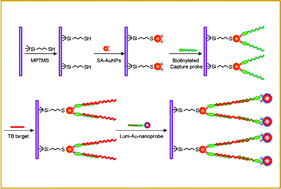The electrogenerated chemiluminescence detection of IS6110 of Mycobacterium tuberculosis based on a luminol functionalized gold nanoprobe
Abstract
A novel electrogenerated chemiluminescence (

* Corresponding authors
a
CAS Key Laboratory of Soft Matter Chemistry, Department of Chemistry, University of Science & Technology of China, Hefei, Anhui, 230026, People's Republic of China
E-mail:
hcui@ustc.edu.cn
Fax: +86-551-3600730
Tel: +86-551-3606645
A novel electrogenerated chemiluminescence (

 Please wait while we load your content...
Something went wrong. Try again?
Please wait while we load your content...
Something went wrong. Try again?
J. Jiang, Y. Chai and H. Cui, RSC Adv., 2011, 1, 247 DOI: 10.1039/C1RA00206F
To request permission to reproduce material from this article, please go to the Copyright Clearance Center request page.
If you are an author contributing to an RSC publication, you do not need to request permission provided correct acknowledgement is given.
If you are the author of this article, you do not need to request permission to reproduce figures and diagrams provided correct acknowledgement is given. If you want to reproduce the whole article in a third-party publication (excluding your thesis/dissertation for which permission is not required) please go to the Copyright Clearance Center request page.
Read more about how to correctly acknowledge RSC content.
 Fetching data from CrossRef.
Fetching data from CrossRef.
This may take some time to load.
Loading related content
